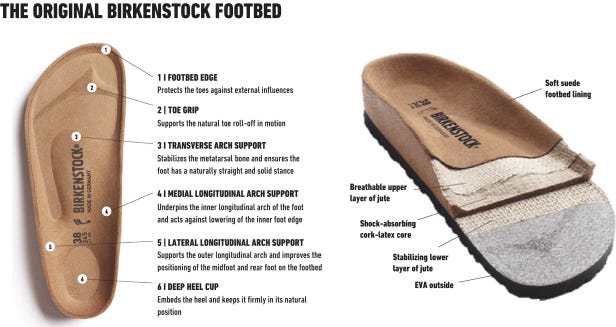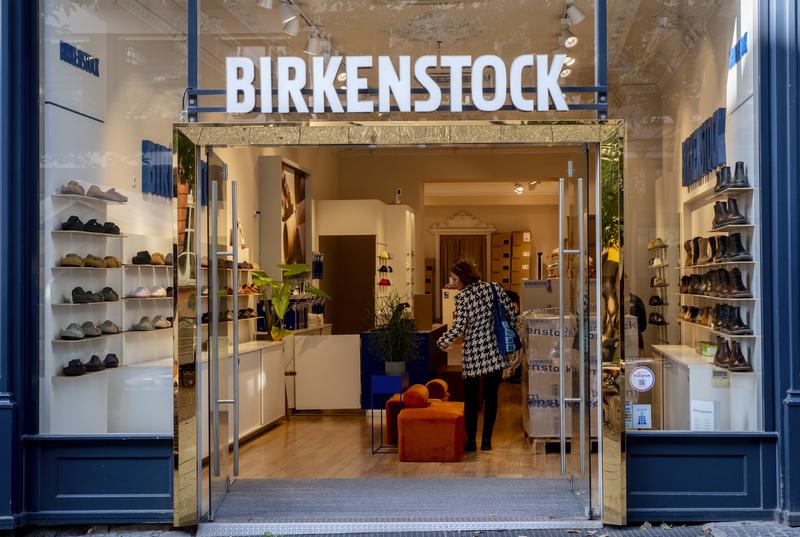Birkenstock is a German footwear brand that has been synonymous with comfort and sustainability for over 250 years. Founded in 1774 by Johann Adam Birkenstock, the company has a rich history of producing high-quality shoes that are both functional and stylish. From its humble beginnings as a small cobbler’s workshop to its current status as a global brand, Birkenstock has remained committed to its core values of quality, innovation, and environmental responsibility.
The company’s early success was built on its ability to produce durable and comfortable footwear for working people, including farmers, craftsmen, and soldiers. The iconic Boston clog, which was introduced in the late 19th century, quickly became a staple in many households due to its versatility and supportive design. As the brand grew in popularity, it expanded its product line to include sandals, boots, and other styles, all of which were designed with the same focus on comfort and functionality.

In recent years, Birkenstock has experienced a resurgence in popularity, particularly among younger generations who value sustainability and ethical production practices. The brand’s commitment to using natural materials, such as leather and suede, and its avoidance of synthetic chemicals and glues have made it a leader in the eco-friendly footwear market. Additionally, Birkenstock’s dedication to fair labor practices and social responsibility has earned it a loyal following among consumers who prioritize ethical consumption.
Today, Birkenstock continues to push the boundaries of sustainable fashion with its innovative designs and collaborations with like-minded brands. Its shoes can be found in over 90 countries worldwide, and the brand remains family-owned and operated, ensuring that its values and mission remain at the forefront of everything it does. Whether you’re looking for a pair of comfortable sandals for everyday wear or a stylish boot for a night out, Birkenstock has something for everyone. In this article, we will explore the history, philosophy, and products of Birkenstock, and why it remains a beloved brand for those who value both style and substance.
Marketing Strategies of Birkenstock
Birkenstock’s success story isn’t solely built on the comfort and functionality of their cork footbeds. The brand has also employed some clever marketing strategies to cultivate its loyal following and navigate the ever-changing footwear landscape. Here’s a closer look at some key marketing strategies that have propelled Birkenstock to its current status:
1. Brand Positioning
Birkenstock carves out a niche in the footwear market with its focus on premium quality and comfort. Their shoes, priced higher than some competitors, are built with high-quality materials and construction, earning them a reputation for durability and long-lasting comfort. This focus on functionality has even positioned them as a status symbol, appealing to a wide range of people seeking both practicality and style.
The brand strategically targets those prioritizing comfort and well-being. Birkenstock caters to individuals with foot issues and those who spend long hours on their feet, like nurses or teachers, with their supportive footbeds designed to minimize pain and fatigue.
Birkenstock’s core brand values solidify this positioning. Their commitment to quality, comfort, durability, and even sustainability through responsible sourcing resonates with customers seeking a well-made, long-lasting product that minimizes their environmental impact. This successful strategy has propelled Birkenstock to become a global leader, recognized for its unique blend of functionality, style, and social consciousness.
2. Product Design and Innovation
Birkenstock’s product design prioritizes functionality and comfort. Their iconic element, the contoured cork footbed, mimics the natural shape of the foot, promoting proper alignment and reducing strain. Deep heel cups and toe bars further enhance stability and comfort, while a variety of widths and sizes cater to diverse foot shapes.

Beyond core elements, Birkenstock embraces innovation. Their Paris studio fosters creativity, leading to special projects and the 1774 collection. This demonstrates their commitment to pushing boundaries while maintaining their signature comfort focus. Material innovation is also evident. They explore sustainable options alongside classic materials like cork and leather, ensuring their product remains relevant to environmentally conscious consumers.

This dedication to comfort-driven design, continuous improvement, and exploration of materials positions Birkenstock at the forefront of footwear innovation. Their core product features remain instantly recognizable, while subtle tweaks and material experimentation ensure their offering stays fresh and relevant to a modern audience.
3. Target Audience
Birkenstock’s core target audience has traditionally been affluent adult women who prioritize comfort, health, and the outdoors. These women likely have a traditional sense of style and appreciate durability. This focus on comfort and well-being has resonated with health-conscious consumers who may experience foot problems or simply value arch support and long-lasting wear. Birkenstock’s success can be attributed to their ability to cater to this key demographic.
However, Birkenstock is showing signs of expanding their target audience. Their recent advertising campaigns target a wider range of ages (15-60 years old), suggesting a move to capture a broader market. This could be due to a few factors. Perhaps their emphasis on comfort is resonating with younger generations, or maybe their classic styles are experiencing a resurgence. Regardless of the reason, Birkenstock seems to be intentionally moving beyond their original niche.
4. Retail Presence
Birkenstock has established a robust retail presence worldwide, catering to its global customer base through a mix of physical and digital channels.
They have a strong foothold in their primary market, the United States, with 54 stores including 3 flagship locations. Birkenstock also has a significant presence in its home country Germany (8 stores) and other regions like India (25 stores). Their reach extends throughout Europe with sales offices in 12 European countries.

In addition to physical stores, Birkenstock leverages the power of online retail. They sell through e-commerce platforms and have invested in company-owned stores, providing convenient access to their products globally. This comprehensive DTC approach ensures customers can easily find Birkenstock sandals regardless of location.
5. E-commerce and Online Presence
Birkenstock has witnessed significant growth in recent years, fueled in part by their strategic expansion into e-commerce and online presence. In 2015, they established Birkenstock digital GmbH, a dedicated unit focused on driving digital initiatives and global online sales. This resulted in a flurry of activity, including a new website, mobile app, and social media engagement. They further expanded their reach by partnering with established online retailers like Amazon and Zappos.
This focus on e-commerce has yielded impressive results. Since 2020, Birkenstock has seen a steady increase in online sales: 92.7% in 2020, followed by 74.1% in 2021, and 51.1% in 2022. This online success can be attributed to several factors. Their strong brand reputation, coupled with high-quality products and a user-friendly e-commerce platform offering features like free shipping and returns, has resonated with customers.
While e-commerce is a major driver, Birkenstock maintains a healthy balance with a strong physical retail presence. They operate 54 stores globally and leverage a network of wholesale partners. This brick-and-mortar presence allows customers to try on shoes before purchase and provides a convenient option for returns and exchanges.
In conclusion, Birkenstock’s success hinges on a well-executed omnichannel strategy. Their robust e-commerce platform caters to the growing online market, while their physical stores complement the digital experience, offering a well-rounded shopping experience for all types of customers.
6. Sustainability and Social Responsibility
Birkenstock stands out for its commitment to sustainability throughout its products and practices.
Compared to other shoe brands, Birkenstock uses a minimal amount of raw materials and relies heavily on organic, recycled, and renewable resources. Cork, a natural material known for its elasticity, cushioning, and insulation, forms a key part of their shoe construction. Additionally, natural latex, jute, leather, wool felt, copper, and brass are all commonly found in Birkenstock footwear.
Beyond materials, Birkenstock actively reduces its environmental footprint. The company utilizes its own eco-friendly power plants that capture generated heat for purposes like drying cork footbeds. This innovative approach significantly reduces energy consumption, with their punches using only 10% of the electricity compared to standard models.
Birkenstock’s social responsibility extends beyond its products. The company enforces a strict Code of Conduct that ensures all suppliers meet minimum social and environmental standards. Furthermore, Birkenstock actively supports various charities and organizations working towards sustainable development and social justice.
In conclusion, Birkenstock goes beyond simply making shoes. They strive to create a positive environmental and social impact through their commitment to sustainable materials, eco-friendly practices, and social responsibility initiatives.
7. Event Sponsorship and Collaborations
Birkenstock actively participates in events to connect with its audience and promote its brand.
- Nationwide Sponsorship: They’ve been the main sponsor of the European Marathon since 2017, aligning with their commitment to promoting youth sports near their company locations.
- Elle Festival Presence: Birkenstock’s role as a presenting sponsor at the Elle Festival highlights their connection to fashion and style.

- NYSE Celebration: Their consumer activations in New York marked a significant brand moment – going public on the Stock Exchange.

Beyond events, Birkenstock fosters strategic brand collaborations.
- Luxury Partners: The collaboration with Manolo Blahnik exemplifies Birkenstock’s ability to bridge comfort and high fashion, with a 70-piece capsule collection.
- Diverse Design Collaborations: Partnerships with Gorman, Jil Sander, Proenza Schouler, Stüssy, and Valentino Garavani showcase Birkenstock’s adaptability across various design aesthetics – from colorful and playful to minimalist, industrial-chic, and even camouflage.
These sponsorships and collaborations allow Birkenstock to connect with new audiences, elevate its brand image, and maintain its position at the forefront of comfort and style.
8. Word-of-Mouth and Reviews
Birkenstock has become a master of word-of-mouth marketing, leveraging the power of customer recommendations to fuel its success. Their shoes, renowned for comfort and durability, naturally spark positive conversations among wearers. Birkenstock further amplifies this effect with strategic initiatives.
Social media serves as a central hub for their word-of-mouth strategy. They actively engage with customers, share product information, and encourage user-generated content. This fosters a community where people share their positive Birkenstock experiences with photos and stories.
Loyalty programs play a smart role too. Customers earn points for purchases, redeemable for future discounts. This not only keeps them coming back but also incentivizes them to spread the word about the brand’s value.
Birkenstock takes word-of-mouth a step further by offering direct incentives. Discounts or free products are sometimes awarded for online reviews or social media posts featuring their sandals. This encourages enthusiastic sharing, attracting new customers through the power of genuine recommendations.
Birkenstock’s success hinges on cultivating a network of brand advocates. By fostering positive word-of-mouth through social engagement, loyalty programs, and targeted incentives, they’ve built a strong reputation for comfort and quality, propelling them to new heights.
By focusing on comfort, leveraging their heritage, and adapting to changing trends, Birkenstock has crafted a successful marketing strategy. Their willingness to embrace new opportunities while staying true to their core values has secured their position as a leading footwear brand for generations to come.
Marketing Mix of Birkenstock
Birkenstock’s enduring success can be attributed to a well-crafted marketing mix, the 4Ps: Product, Price, Place, and Promotion. Let’s delve into each element to understand how Birkenstock strategically positions itself in the market.
1. Product
Comfort & Durability: Birkenstock’s core strength lies in its commitment to comfort and long-lasting quality. Their cork footbed, combined with high-quality materials, translates to a loyal customer base who appreciates the difference.
Style Expansion: While classic styles like the Arizona and Gizeh remain iconic, Birkenstock has expanded their product line. They offer sandals, clogs, boots, and even sneakers, catering to a wider range of tastes and needs.
Material Innovation: Birkenstock embraces sustainable and ethically sourced materials like natural cork and Birko-Flor (a vegan leather alternative). This resonates with eco-conscious consumers.
Customization: Limited edition collections and collaborations with designers add a touch of exclusivity and cater to fashion-forward customers.
2. Price
Premium Pricing: Birkenstock positions itself as a premium brand. Their prices reflect the quality materials, craftsmanship, and durability of their products.
Value Perception: Despite the premium price tag, Birkenstock cultivates a perception of value for money. The long-lasting nature of their shoes justifies the initial investment for many consumers.
Selective Discounting: Birkenstock employs strategic discounts during sales or through their loyalty program. This maintains the brand’s premium image while attracting price-conscious buyers at specific times.
3. Place
Omnichannel Distribution: Birkenstock utilizes a blend of online and offline channels to reach customers conveniently. Their website offers a seamless buying experience, while partnerships with established retailers ensure broad physical availability.
Selective Distribution: They carefully select retailers that align with their brand image. This ensures a consistent brand experience for customers across all purchase channels.
Direct-to-Consumer Focus: Birkenstock has been increasingly focusing on their direct-to-consumer sales through their own online store. This allows them greater control over brand messaging and customer relationships.
4. Promotion
Word-of-Mouth Marketing: As discussed earlier, Birkenstock excels at cultivating positive word-of-mouth through social media engagement, loyalty programs, and customer incentives. This organic brand advocacy is a cornerstone of their promotional strategy.
Targeted Social Media: Birkenstock utilizes social media platforms like Instagram and Facebook to connect with their target audience. They leverage influencer marketing strategically to reach new demographics and showcase the versatility of their products.
Emotional Connection: Birkenstock’s marketing campaigns often evoke a sense of comfort, well-being, and a carefree lifestyle. This emotional connection resonates with their target audience and fosters brand loyalty.
Limited Collaborations: Collaborations with renowned designers or brands create a sense of exclusivity and desirability. This targeted approach generates excitement and keeps Birkenstock relevant in the ever-evolving fashion landscape.
By meticulously crafting their marketing mix, Birkenstock has carved out a unique position in the footwear industry. Their focus on comfort, durability, and brand experience fosters a loyal customer base that advocates for the brand, propelling Birkenstock’s continued success.
Also Read: Marketing Strategies and Marketing Mix of Rick Owens
To read more content like this, subscribe to our newsletter



